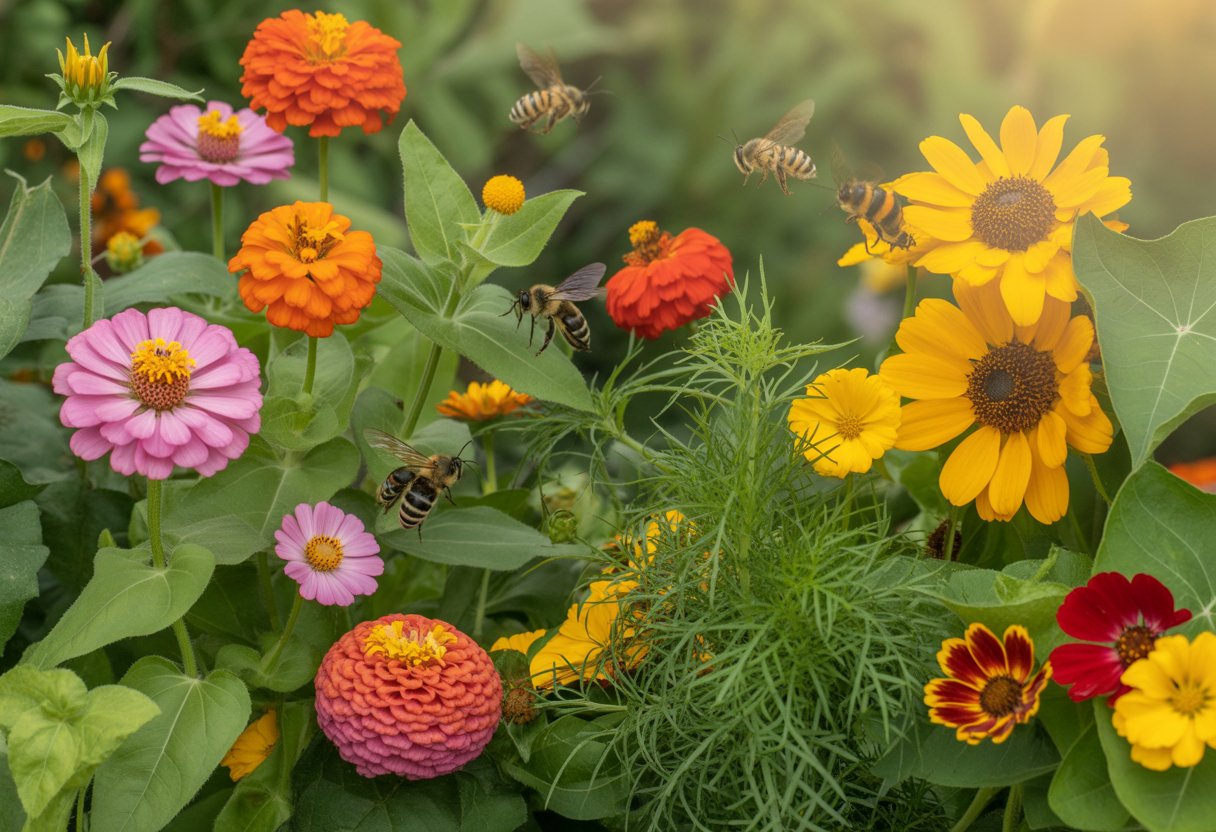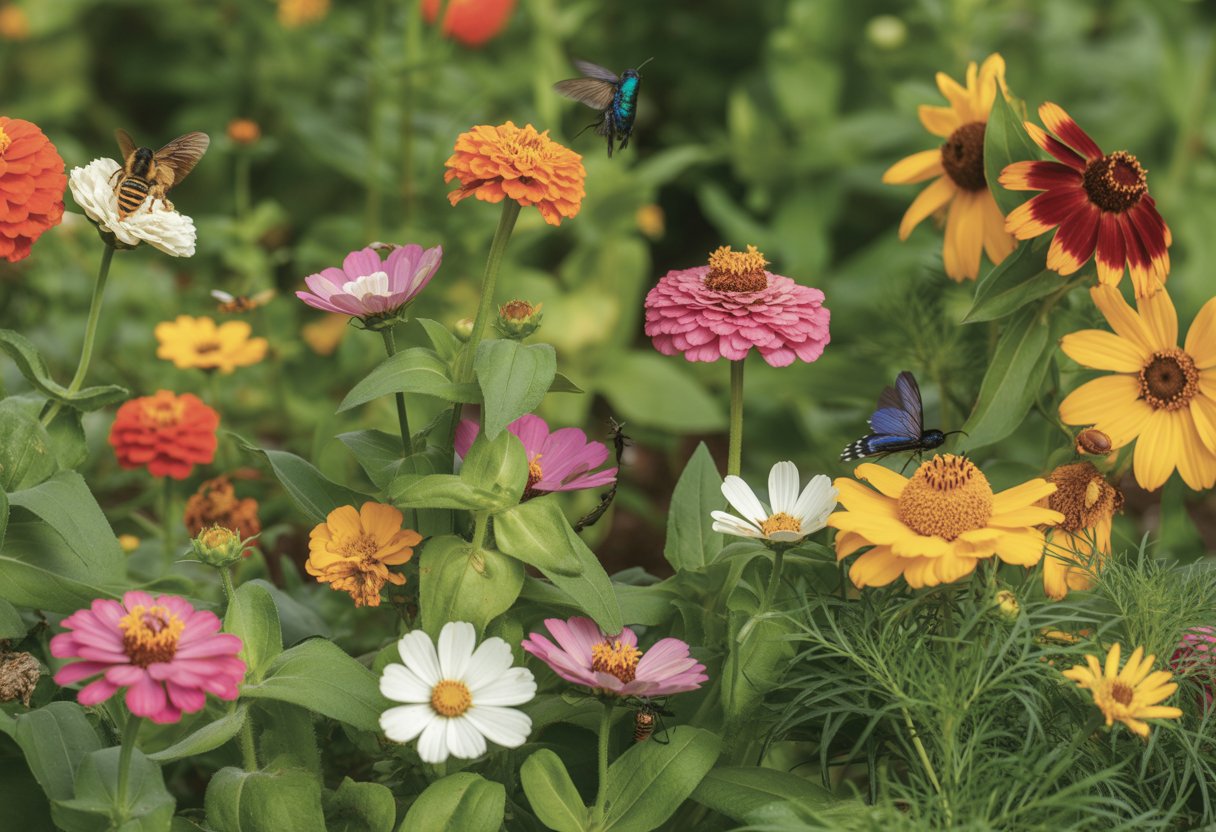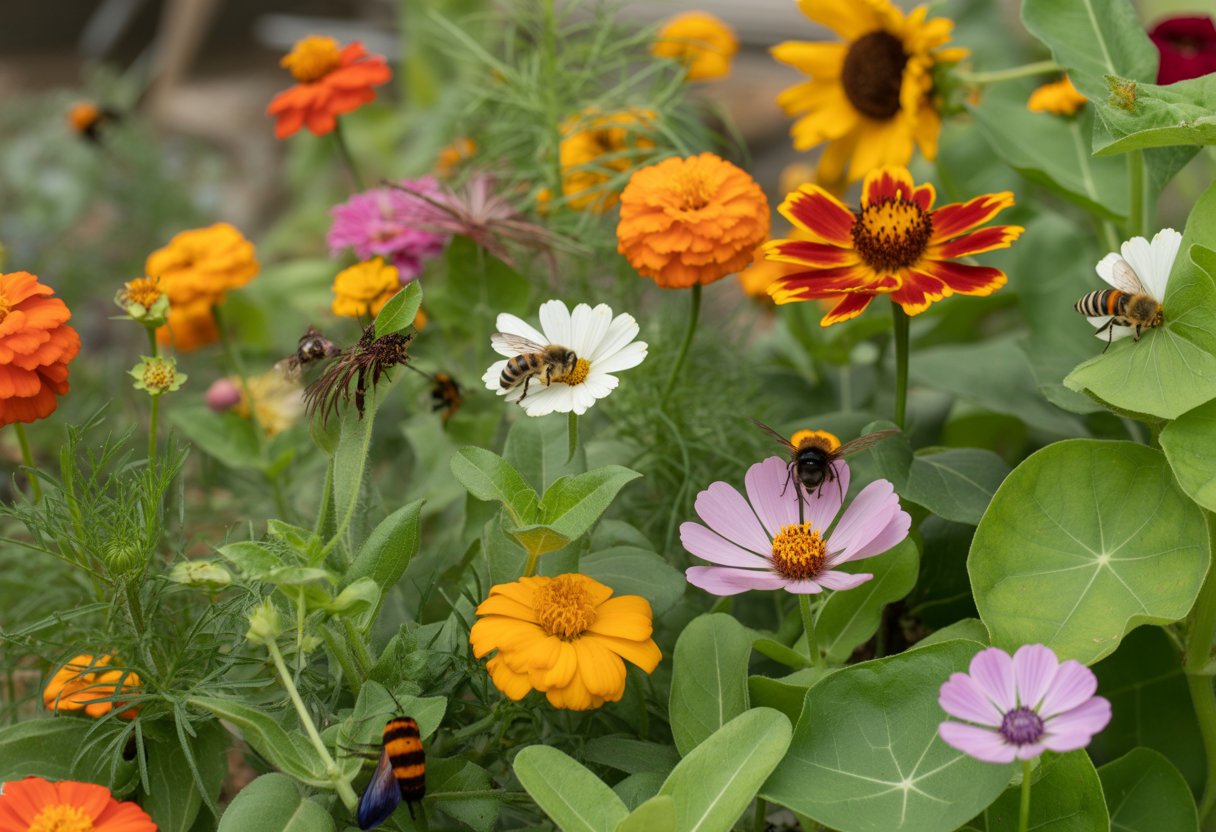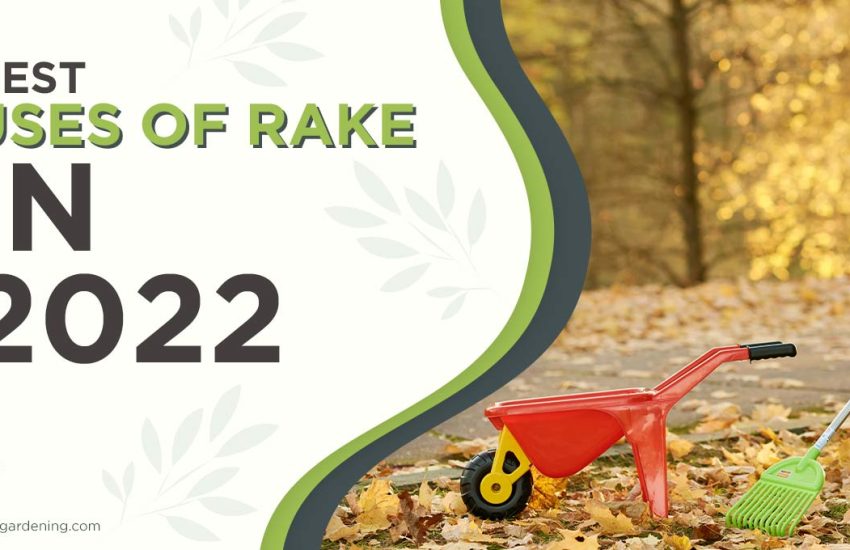Top Annuals for Pollinators that Boost Your Garden’s Health and Beauty
A lot of gardeners want to bring in pollinators like bees, butterflies, and hummingbirds. Picking the right annual plants really matters because these flowers give out nectar and pollen all season long.
The top annuals for pollinators are those that bloom continuously, offer abundant nectar, and have shapes suited to different pollinator species.

Zinnias, marigolds, cosmos, and sunflowers are some of the classics for attracting all sorts of pollinators. These annuals support bees and butterflies with easy-to-reach food, and their bright, tubular blooms pull in hummingbirds too.
Mixing these flowers creates a more welcoming spot for all kinds of pollinators.
Why Choose Annuals for Pollinator Gardens

Annuals bring something special to pollinator-friendly gardens. They let you switch up bloom times and flower choices every year, so pollinators always have a reliable food source.
Their adaptability pairs well with perennials, keeping the garden lively and helpful for pollinators as the months go on.
Benefits of Annuals Over Perennials
Annuals bloom like crazy in just one season, pumping out nectar and pollen when it’s needed most. Perennials might only bloom for a short stretch, but annuals can fill in the gaps and keep the flowers coming from spring through fall.
They get established fast—sometimes in just a few weeks. That means you can quickly adjust your plant choices to attract different pollinators or swap out anything that’s not thriving.
Annuals also handle disturbances better, so they work well in new or changing gardens.
Supporting Pollinators Through the Seasons
Annuals step up when perennials aren’t blooming. Early-blooming annuals help bees waking up in spring, while others keep flowering into late fall for pollinators prepping for winter.
If you plant annuals with different bloom times, you’ll have nectar and pollen available for pollinators all season. That’s a big help for their survival and supports a wider range of species.
Role of Annuals in Pollinator-Friendly Gardens
Annuals boost both the variety and number of flowers, which pollinators really need. Bees, butterflies, and hoverflies all show up for the mix of shapes and colors.
Besides feeding pollinators, annuals make gardens look great and can help the soil. Their seasonal growth lets you refresh the soil and keep weeds in check, which helps create a more balanced ecosystem.
Top Annual Flowers for Pollinators
Annual flowers are a steady source of nectar and pollen all season. Picking the right ones supports bees, butterflies, and hummingbirds by giving them plenty of easy-to-reach blooms.
Best Annuals for Bees
Bees—bumble bees, honey bees, and others—love flowers with lots of nectar and pollen, especially those with open petals. Zinnias, marigolds, and alyssum are some of the best, thanks to their nectar production and eye-catching colors.
Zinnias attract all sorts of native bees and bloom like champs in the sun. Marigolds are loaded with pollen and even help keep some pests away.
Alyssum’s tiny, clustered flowers give off plenty of nectar, so both honey bees and bumble bees benefit.
You can also try annual varieties of bee balm and catmint—these have fragrant, nectar-rich flowers that bees just can’t resist.
Flowers to Attract Butterflies
Butterflies look for flowers with flat landing spots and bold colors like purple, red, and yellow. Pentas, lantana, and zinnia are some of the best annuals to bring butterflies into your garden.
Pentas bunch their flowers together, making the perfect place for butterflies to rest and feed. Lantana blooms non-stop, keeping butterflies around from summer into fall.
Zinnias, with their wide petals and bright hues, are another butterfly favorite.
Butterflies also like flowers with sweet scents and easy-to-reach nectar. Combining these plants can keep butterflies coming all season.
Annuals Preferred by Hummingbirds
Hummingbirds go for tubular, bright flowers with lots of nectar. Lantana, pentas, and bee balm all fit the bill, drawing hummingbirds in with their reds, pinks, and oranges.
Lantana’s clusters offer lots of nectar and bloom for months. Pentas have tubular flowers that match hummingbird beaks—nature really nailed that design.
Bee balm, often a perennial, is available as an annual too, and its flowers are a magnet for hummingbirds.
Throwing in some geraniums adds even more nectar spots and can keep hummingbirds interested all season.
Unique Annual Choices for Diverse Pollinators
Some annuals help several pollinator groups at once, which boosts garden biodiversity. Try mixing alyssum, catmint, and marigolds for a layered look with different flower types and bloom times.
Alyssum draws in tiny bees and helpful insects with its low, spreading flowers. Catmint’s aromatic leaves are a hit with bees, even if the nectar’s not super plentiful.
Marigolds bring in bees with their bright, pollen-packed blooms and also help keep pests away.
A mix like this supports honey bees, bumble bees, butterflies, and hummingbirds, giving them plenty to choose from. That kind of diversity makes gardens and local ecosystems stronger.
Designing a Successful Pollinator-Friendly Garden with Annuals
Building a pollinator-friendly garden means paying attention to layout, plant placement, and the environment. Using containers and making the most of your space helps annuals thrive and keeps the blooms coming for bees, butterflies, and other pollinators.
Garden Layout for Maximum Pollinator Attraction
A smart garden layout clusters pollinator-friendly plants, making it easier for bees and butterflies to find food. Group annuals that bloom at the same time to stretch out feeding opportunities.
Put plants in sunny spots—most pollinators love the sun.
Mix up flower shapes and colors to draw in different pollinators. Taller annuals can go in the back, with shorter ones up front, creating layers and blocking wind.
Paths or open spots help pollinators move from bloom to bloom.
Working native annuals into your mix can give local pollinators a boost. Try not to crowd the plants too much—tight planting can make it tough for pollinators to get around.
Planting in Containers and Outdoor Spaces
Containers give you flexibility for growing annuals, especially if you’re short on space. Make sure pots drain well and get at least six hours of sun each day.
Containers let you control soil quality and keep weeds at bay.
For outdoor beds, pick spots with well-draining soil. Mix in organic matter to hold moisture but avoid soggy roots.
Placing containers near patios or walkways makes it easy to enjoy the flowers and spot pollinators up close.
Rotating annuals in containers each season helps keep blooms coming and cuts down on pests. It also gives soil a chance to recover.
Choosing the Right Conditions for Annuals
Annuals need the right light, water, and soil to really shine. Most pollinator-friendly annuals want full sun—at least six hours a day.
If they get too much shade, you’ll see fewer flowers and less nectar.
Keep watering consistent, especially when it’s dry, but don’t let the soil get soggy. Good drainage helps prevent root rot.
Garden centers usually suggest soil mixes rich in organic matter to keep plants healthy.
Pick annuals that match your local climate to save on maintenance. Give them enough space to avoid disease and let air move around.
Mulching helps hold moisture and keeps weeds down, which makes life easier for both you and the pollinators.
Maintaining Annuals to Support Pollinators All Season

Caring for annuals keeps nectar and pollen flowing all season. Good maintenance means more blooms and more pollinators—plus helpful insects like wasps.
Best Practices for Continuous Bloom
Remove faded flowers (deadheading) to encourage new blooms and keep the plant focused on flowering instead of making seeds.
Water regularly, especially when it’s dry, since thirsty plants don’t bloom as much. Feed lightly every few weeks with a balanced, water-soluble fertilizer for vibrant flowers.
Plant a mix of annuals with different bloom times—cosmos, zinnias, sunflowers—so there’s always something for pollinators.
Keep an eye out for pests and diseases, and deal with problems early. Avoid using broad-spectrum pesticides since they can harm the good bugs you want to keep around.
Attracting Beneficial Insects With Annuals
Bringing in annuals that offer a mix of pollen and nectar really ramps up visits from pollinators and predators like wasps. Marigolds and alyssum, for example, attract helpful insects that end up keeping pests in check.
If you set up shelter or nesting sites near your annual beds, you give these beneficial insects a reason to stick around. Packing plants closely together and tossing in a few flowering herbs makes the area even more welcoming.
Choosing annuals with open, easy-to-reach flowers draws in more pollinators—bees, butterflies, you name it. It’s a simple way to encourage a healthier, more balanced ecosystem, where pollinators and natural pest controllers can both do their thing.


